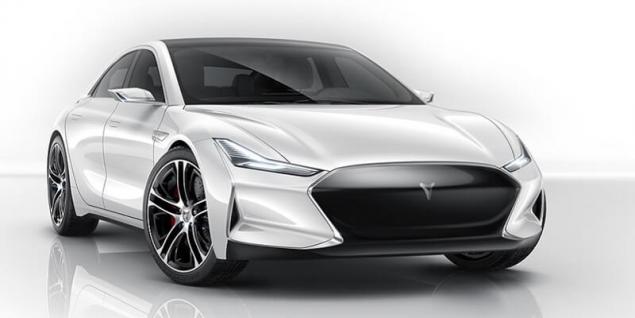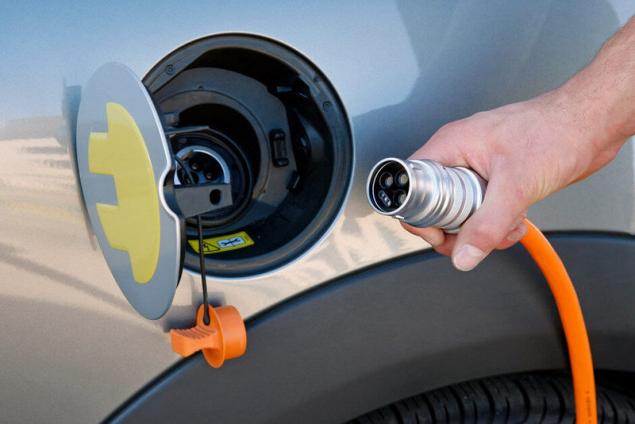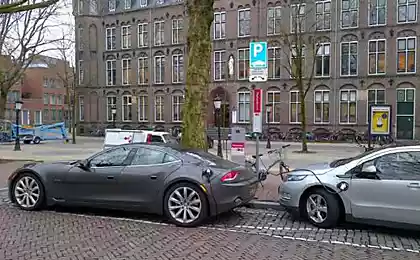279
The Future of Electric Vehicles
The February publication of a study by the Transport for London (Transport for London) marred the dream of a common good that should come with the transition of all passenger transport to electricity. This will cause, according to the study, congestion of power grids, and to charge all electric vehicles, London will need 7-8 GWh per year.

That’s exactly how much electricity two “medium” reactors produce. Well, if you switch to electricity transport throughout Britain, then to feed the electric vehicles will have to build 20 reactors. Otherwise, there won't be enough electricity.
The author of the article was unable to read this study. But his findings are suspiciously reminiscent of predictions of the early twentieth century. If you remember, then seriously argued that the rapid development of urban transport will certainly lead to the fact that Londoners will walk knee-deep in dung. So, trying to look into the future, we will limit ourselves to reasonable and methodically correct forecasts.
And to save space, denote electric cars by the abbreviation EV (Electric Vehicle).
IEA: Consumers vote for electric cars
The International Energy Agency, in its World Energy Outlook 2016 report, notes that the world’s EV fleet reached 1.3 million in 2015 – almost twice as many as in 2014.
Note that these calculations do not take into account the extremely popular electric and hybrid two-wheelers in India and China, the fleet of which is estimated in the millions. In 2013, there were 180 million electric bikes on China’s roads, and in 2016, sales of electric two-wheelers in the Asia-Pacific region amounted to 32.8 million units.
For EVs to become a truly mass-produced commodity, the IEA believes, the following conditions are needed:
Government support for EVs and encouragement of consumer choice in their favor is far from universal. But there is no doubt that if fuel efficiency and emissions regulations become tighter, and financial incentives for producers and consumers are more generous, the IEA’s ambitious scenario would see an estimated 715 million electric vehicles on the road by 2040, with oil consumption correspondingly reduced by 6 million barrels per day.
So, the growth of EV sales in 2015 was about 50% (IEA), and in 2016 – even 60% (BNEF). That’s the kind of growth in sales until 2020 — 50-60% per year — Tesla predicts; the same rate grew sales of the famous Ford Model T, which survived the market of horse-drawn vehicles in the 1910s. For comparison, we can cite the annual growth in sales of solar panels (50%) and LED light bulbs (140%).
All this proves that we are not dealing with short-term fashion, but with a large-scale technological shift, which is better to prepare for. Consider another prediction, which is also an example of the understatement of the speed of change in society and technology: when Henry Ford’s lawyer decided in 1909 to become a co-owner of his famous client’s car company, the president of the Michigan Savings Bank told him, “Don’t do it.” There will always be horses and cars are just a temporary fad.”
According to the main development scenario developed by the IEA, the number of EVs will exceed 30 million by 2025 and reach 150 million in 2040, thereby reducing oil demand by about 1.3 million barrels per day. However, the IEA believes that the dependence of electricity demand on electric vehicles – especially against the background of a forecast of a sharp increase in total energy consumption – will remain insignificant.
Ah, yes, oil... Know that electric cars, among other misfortunes, threaten the world with peak oil, that is, lower oil consumption.
Peak oil consumption?
According to media reports, Tesla, Chevy and Nissan plan to start selling long-haul cars in the coming years at a price of about $ 30,000. It is possible that by 2020, some models will be cheaper than their counterparts with internal combustion engines (and smell better). How will this technological shift affect oil demand? Will it go down enough to lead to another oil crisis?
Today, electric vehicles (including combined ones, which have both internal combustion engines and batteries) make up a tenth of a percent of the global car market. They are rarely seen on the streets and are still substantially more expensive than their petrol and diesel counterparts. OPEC, Exxon and Conoco believe EVs will make up just one or two percent of the global fleet by 2040. The same view is held by many top executives of global oil corporations.
The latter in their predictions are based on conventional ideas and everyday wisdom: “Hurry slowly and do not listen to the fantasists.” They are based on the total cost of ownership of EVs (maintenance, fuel costs or, in our case, battery recharging and the cost of the batteries themselves).
Perhaps analysts are exaggerating, believing that as early as 2023, due to an increase in the number of EVs, oil demand will decrease by 1.3 million (IEA) or 2 million (BNEF) barrels per day. But those who remember the reasons for the glut of the oil market in 2014, which was caused by a halving of oil prices, this forecast will not seem exaggerated.

However, the annual growth of new EV sales by 50-60% is likely to not last long, and the aggressive forecast of a decrease in daily oil demand needs to be adjusted. In addition, the interest of the mass buyer is dictated mainly by price. This means it’s worth monitoring the prices of EV components to see when they’ll drop enough to lure the average car buyer. Analysts call 2028 a turning point in this regard. This is a conservative version of the forecast.
The skepticism of oil producers is also based on the lack of a sufficient number of fast charging stations, and on the general unavailability of the power grid, which will deter long-distance EV travel. A lot will also depend on EV sales in China and India. And rising oil demand in developing countries – especially if oil prices continue to fall – could outweigh the negative impact of EVs.
Where can I get the power?
One thing is certain: no one knows how many people will use EVs in the future. But it is clear that with the growth of electric vehicle sales, the electricity infrastructure will change.
The opposite is true: if infrastructure changes lag behind sales and networks begin to experience congestion, demand for EVs will decline, and consumers, tired of inconvenience, will return to a traditional car. Perhaps a temporary solution can be a hybrid transport, many models of which are available today.
But there’s another side to the rise in electric vehicles: where do you get the power to charge your huge EV fleet? Based on the BNEF forecast, they will consume 1,900 terawatt-hours of electricity by 2040. This represents 10% of global electricity production in 2015.
There are other opinions. Nordic countries are known for their commitment to green solutions, high mobility, and the number of electric vehicle sales. Scientists in these countries have long been concerned with the problem of energy consumption and infrastructure for EVs.

Thus, the journal Energy published an article that examines the one-hundred-cent electricity conversion of passenger transport in Denmark, Finland, Norway and Sweden by 2050*. The author of the article claims that electricity consumption will grow by a maximum of 7-7.5%, that is, “only” by 30 terawatt-hours per year. At the same time, the “stupid” model of charging batteries gives peak loads in the morning and evening, and the “smart” model based on the spot price predicted for the day ahead gives an increase in consumption during periods of low prices, that is, at night.
Regardless of the prevailing model, the increase in electricity consumption is expected to be covered by bioenergy, nuclear energy and small imports of electricity (even from fossil fuels, but produced in other neighboring countries).
Researchers from the Netherlands did not consider the option of one hundred percent transfer of passenger transport to electricity and limited to 30% of the “penetration” of electric vehicles in everyday life**. According to their calculations, in these conditions, the national load at peak times will increase by 7%, and in households by 54%, which exceeds the capabilities of the existing energy distribution infrastructure. If you charge cars at night, the national load will increase by 20%.
To sum up. Electricity consumption will rise, with the IEA forecasting that most of the growth will come from non-OECD countries. These are mainly Asian and African countries. At the same time, the IEA does not name the exact figure for the growth of energy consumption attributable to electric cars. There are too many unknowns in the electric-vehicle-energy equation, too many factors, including the rapid growth of energy consumption, the changing energy structure, and the readiness of infrastructure for EVs.
Two more unknowns in this equation are the rise of self-driving cars and sharing services like Uber and LYFT. The growth in the supply of these services could increase the market share of EVs among new cars to 50% by 2040.
In any case, electric cars will not eat people. And the forecast of the respected Transport for London, which transports residents of 10 million Greater London, is hardly relevant to reality. But it became an occasion to talk about forecasts, electric cars and horror stories for adults. published
P.S. And remember, just changing our consumption – together we change the world!
Source: //atomicexpert.com/page785215.html

That’s exactly how much electricity two “medium” reactors produce. Well, if you switch to electricity transport throughout Britain, then to feed the electric vehicles will have to build 20 reactors. Otherwise, there won't be enough electricity.
The author of the article was unable to read this study. But his findings are suspiciously reminiscent of predictions of the early twentieth century. If you remember, then seriously argued that the rapid development of urban transport will certainly lead to the fact that Londoners will walk knee-deep in dung. So, trying to look into the future, we will limit ourselves to reasonable and methodically correct forecasts.
And to save space, denote electric cars by the abbreviation EV (Electric Vehicle).
IEA: Consumers vote for electric cars
The International Energy Agency, in its World Energy Outlook 2016 report, notes that the world’s EV fleet reached 1.3 million in 2015 – almost twice as many as in 2014.
Note that these calculations do not take into account the extremely popular electric and hybrid two-wheelers in India and China, the fleet of which is estimated in the millions. In 2013, there were 180 million electric bikes on China’s roads, and in 2016, sales of electric two-wheelers in the Asia-Pacific region amounted to 32.8 million units.
For EVs to become a truly mass-produced commodity, the IEA believes, the following conditions are needed:
- The government takes measures to encourage cost reduction;
- Producers accept falling profits.
- buyers are willing to pay more for electric cars than for cars with internal combustion engines;
- The cost of batteries has drastically decreased.
Government support for EVs and encouragement of consumer choice in their favor is far from universal. But there is no doubt that if fuel efficiency and emissions regulations become tighter, and financial incentives for producers and consumers are more generous, the IEA’s ambitious scenario would see an estimated 715 million electric vehicles on the road by 2040, with oil consumption correspondingly reduced by 6 million barrels per day.
So, the growth of EV sales in 2015 was about 50% (IEA), and in 2016 – even 60% (BNEF). That’s the kind of growth in sales until 2020 — 50-60% per year — Tesla predicts; the same rate grew sales of the famous Ford Model T, which survived the market of horse-drawn vehicles in the 1910s. For comparison, we can cite the annual growth in sales of solar panels (50%) and LED light bulbs (140%).
All this proves that we are not dealing with short-term fashion, but with a large-scale technological shift, which is better to prepare for. Consider another prediction, which is also an example of the understatement of the speed of change in society and technology: when Henry Ford’s lawyer decided in 1909 to become a co-owner of his famous client’s car company, the president of the Michigan Savings Bank told him, “Don’t do it.” There will always be horses and cars are just a temporary fad.”
According to the main development scenario developed by the IEA, the number of EVs will exceed 30 million by 2025 and reach 150 million in 2040, thereby reducing oil demand by about 1.3 million barrels per day. However, the IEA believes that the dependence of electricity demand on electric vehicles – especially against the background of a forecast of a sharp increase in total energy consumption – will remain insignificant.
Ah, yes, oil... Know that electric cars, among other misfortunes, threaten the world with peak oil, that is, lower oil consumption.
Peak oil consumption?
According to media reports, Tesla, Chevy and Nissan plan to start selling long-haul cars in the coming years at a price of about $ 30,000. It is possible that by 2020, some models will be cheaper than their counterparts with internal combustion engines (and smell better). How will this technological shift affect oil demand? Will it go down enough to lead to another oil crisis?
Today, electric vehicles (including combined ones, which have both internal combustion engines and batteries) make up a tenth of a percent of the global car market. They are rarely seen on the streets and are still substantially more expensive than their petrol and diesel counterparts. OPEC, Exxon and Conoco believe EVs will make up just one or two percent of the global fleet by 2040. The same view is held by many top executives of global oil corporations.
The latter in their predictions are based on conventional ideas and everyday wisdom: “Hurry slowly and do not listen to the fantasists.” They are based on the total cost of ownership of EVs (maintenance, fuel costs or, in our case, battery recharging and the cost of the batteries themselves).
Perhaps analysts are exaggerating, believing that as early as 2023, due to an increase in the number of EVs, oil demand will decrease by 1.3 million (IEA) or 2 million (BNEF) barrels per day. But those who remember the reasons for the glut of the oil market in 2014, which was caused by a halving of oil prices, this forecast will not seem exaggerated.

However, the annual growth of new EV sales by 50-60% is likely to not last long, and the aggressive forecast of a decrease in daily oil demand needs to be adjusted. In addition, the interest of the mass buyer is dictated mainly by price. This means it’s worth monitoring the prices of EV components to see when they’ll drop enough to lure the average car buyer. Analysts call 2028 a turning point in this regard. This is a conservative version of the forecast.
The skepticism of oil producers is also based on the lack of a sufficient number of fast charging stations, and on the general unavailability of the power grid, which will deter long-distance EV travel. A lot will also depend on EV sales in China and India. And rising oil demand in developing countries – especially if oil prices continue to fall – could outweigh the negative impact of EVs.
Where can I get the power?
One thing is certain: no one knows how many people will use EVs in the future. But it is clear that with the growth of electric vehicle sales, the electricity infrastructure will change.
The opposite is true: if infrastructure changes lag behind sales and networks begin to experience congestion, demand for EVs will decline, and consumers, tired of inconvenience, will return to a traditional car. Perhaps a temporary solution can be a hybrid transport, many models of which are available today.
But there’s another side to the rise in electric vehicles: where do you get the power to charge your huge EV fleet? Based on the BNEF forecast, they will consume 1,900 terawatt-hours of electricity by 2040. This represents 10% of global electricity production in 2015.
There are other opinions. Nordic countries are known for their commitment to green solutions, high mobility, and the number of electric vehicle sales. Scientists in these countries have long been concerned with the problem of energy consumption and infrastructure for EVs.

Thus, the journal Energy published an article that examines the one-hundred-cent electricity conversion of passenger transport in Denmark, Finland, Norway and Sweden by 2050*. The author of the article claims that electricity consumption will grow by a maximum of 7-7.5%, that is, “only” by 30 terawatt-hours per year. At the same time, the “stupid” model of charging batteries gives peak loads in the morning and evening, and the “smart” model based on the spot price predicted for the day ahead gives an increase in consumption during periods of low prices, that is, at night.
Regardless of the prevailing model, the increase in electricity consumption is expected to be covered by bioenergy, nuclear energy and small imports of electricity (even from fossil fuels, but produced in other neighboring countries).
Researchers from the Netherlands did not consider the option of one hundred percent transfer of passenger transport to electricity and limited to 30% of the “penetration” of electric vehicles in everyday life**. According to their calculations, in these conditions, the national load at peak times will increase by 7%, and in households by 54%, which exceeds the capabilities of the existing energy distribution infrastructure. If you charge cars at night, the national load will increase by 20%.
To sum up. Electricity consumption will rise, with the IEA forecasting that most of the growth will come from non-OECD countries. These are mainly Asian and African countries. At the same time, the IEA does not name the exact figure for the growth of energy consumption attributable to electric cars. There are too many unknowns in the electric-vehicle-energy equation, too many factors, including the rapid growth of energy consumption, the changing energy structure, and the readiness of infrastructure for EVs.
Two more unknowns in this equation are the rise of self-driving cars and sharing services like Uber and LYFT. The growth in the supply of these services could increase the market share of EVs among new cars to 50% by 2040.
In any case, electric cars will not eat people. And the forecast of the respected Transport for London, which transports residents of 10 million Greater London, is hardly relevant to reality. But it became an occasion to talk about forecasts, electric cars and horror stories for adults. published
P.S. And remember, just changing our consumption – together we change the world!
Source: //atomicexpert.com/page785215.html





















